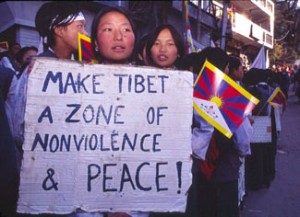Marginalisation and Exclusion
 Fifty years after China’s invasion, Beijing is intensifying its control over Tibet and its approximately six million Tibetans.
Fifty years after China’s invasion, Beijing is intensifying its control over Tibet and its approximately six million Tibetans.
Tibetans are facing increasing marginalization as their economy becomes integrated with China and its population of 1.3 billion. They are losing out under the ‘Westerndevelopment’ strategy, a massive campaign launched in 1999 to improve infrastructure in China’s thinly-populated west, including Tibetan areas of China. The Chinese government has constructed a railway across the Tibetan plateau to Tibet’s capital, Lhasa, which will increase the numbers of Chinese commercial migrants into Tibet, resulting in the further militarization of the region and accelerating the exploitation of Tibet’s natural and mineral resources
China’s fast track economic policies in Tibet, based on a political agenda, are directly linked to the repression of the Tibetan people. They are the most serious modern threat to the survival of Tibet’s unique religious, cultural and linguistic identity.
The Chinese government claims that it is pouring money into health and education to benefit Tibetans. But the majority of Tibetans who live in rural areas do not have access to adequate or affordable health care and are still suffering from easily treatable conditions such as malnutrition, diarrhea, pneumonia, or even the plague.
Education facilities and opportunities for the Tibetan children are minimal and many Tibetan parents cannot afford schooling So they send their children into exile to study at Tibetan schools in India. Often education that is available in Tibet suppresses Tibetan religious or linguistic identity.
Religion and Culture
Approximately 6,000 monasteries, nunneries and temples, and their contents were partially or fully destroyed from the period of the Chinese invasion and during the Cultural Revolution.
The repression of Tibet’s culture and religion continues today. Tibetan Buddhism is an integral element of Tibetan national identity, and measures used to implement Chinese government religious policy have been harsh.
China, which promotes atheism, aims to undermine the Dalai Lama’s influence in Tibet and maintains strict control over monasteries and nunneries. Political campaigns or “patriotic re-education” require forced denunciations of the Dalai Lama, and there are restrictions on religious pilgrimages. Obtaining a religious education remains extremely difficult or impossible in Tibet.
Tibet’s religious heritage has made a profound impact worldwide and has a unique contemporary relevance. The Dalai Lama has pioneered a dialogue with scientists on human consciousness, drawing on ancient Buddhist texts, and Tibetan Buddhist lamas teach across the globe.
The tradition of peaceful co-existence in pre-occupation Tibet among Tibetan Buddhists and Muslims serves as a model of religious tolerance, and the Dalai Lama’s efforts to promote interfaith understanding continues to this day.
Over the past 50 years, Tibetans have expressed their resistance to Chinese rule through the assertion of their cultural and religious identity. Following the Cultural Revolution, they rebuilt monasteries and temples in Tibetan communities. Today, Tibetans worship at secret shrines to the Dalai Lama, express their dissent through pop music or poetry and protect their Tibetan identity by keeping their language and traditions alive.
Political Repression
The Chinese government severely restricts the rights of Tibetans to exercise human rights as provided in the Chinese constitution, including the freedoms of speech, press, association, and religion. Reading an autobiography of the Dalai Lama or talking about freedom to friends in Tibet can be classified as ‘endangering state security’.
Tibetan political prisoners endure harsh prison conditions, including torture, deprivation of food and sleep, and long periods in isolation cells.
“When they were torturing us it was literally as if they were trying to kill us. Prison guards would hit and beat with all their strength. Once after we all shouted ‘Long live the Dalai Lama’ they started to kick and beat us so much that the ground was covered inblood.”
– Ngawang Sangdrol, 28, paroled in 2002 after 11 years in prison for peaceful protests
Environment
With an average elevation of 14,000 feet, Tibet is the highest country on earth. Tibet’s fragile high-altitude environment is increasingly endangered by China’s exploitative policies.
This matters to the rest of Asia and the world. Five of Asia’s great rivers have their headwaters in Tibet and nearly half the world’s population lives downstream. Deforestation in Tibet has already been linked to severe floods in the lower reaches of the Yangtze in China.
The high plains, forests and mountains of Tibet are home to rare and endangered wildlife such as the snow leopard, blue sheep and Tibetan antelope (chiru). Due to extensive resource extraction, poaching and unsustainable development, these ecosystems and many of their species are now endangered.
The forced settlement of nomads is wiping out a unique way of life, increasing poverty and contributing to grassland degradation.

